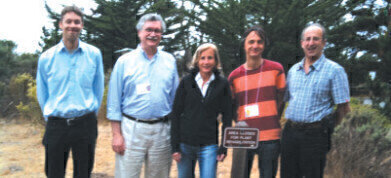-
 Julian Hibberd (Cambridge), John Golbeck (Penn State, US PI), Cheryl Kerfeld (Berkeley), Nigel Burroughs (Warwick), Mike Blatt (Glasgow, UK PI)
Julian Hibberd (Cambridge), John Golbeck (Penn State, US PI), Cheryl Kerfeld (Berkeley), Nigel Burroughs (Warwick), Mike Blatt (Glasgow, UK PI)
News & Views
University of Warwick Using MAGIC on Plant Productivity
May 16 2011
The Systems Biology Centre in the University of Warwick has just been awarded a research grant from BBSRC together with collaborators in Cambridge, Glasgow and the USA to work on substantially improving the photosynthesis efficiency of plants. The grant award to the full collaboration is for £1.6 million.
“Plants are in fact poor convertors of light energy, less than 1/10th of the light energy being converted into biomass, and substantially less is converted into a useful food product,”
explained Professor Nigel Burroughs from The Systems Biology Centre at Warwick University. “The source of this inefficiency runs very deep, the crucial enzyme (called Rubisco, in fact the most abundant protein on the planet) has a low preference for utilising carbon dioxide relative to oxygen, while only use of the former fixes carbon dioxide into useful products such as sugars.
This property is a remnant from when Rubisco evolved 3500 million years ago, a time when carbon dioxide was very plentiful and oxygen levels negligible. Some plants have evolved mechanisms to deal with this as oxygen levels have increased, but most crops today, such as rice, remain inefficient because of this poor enzyme.” The UK scientists along with along with researchers in Pennsylvania and Berkeley are tackling this problem using Multi-level Approaches for Generating Increased CO2, or MAGIC, to engineer a carbon dioxide capturing mechanism inside the plant using the latest techniques in synthetic biology. This can be thought of as nano bioengineering, the idea being to design a scaffold that funnels carbon dioxide direct to Rubisco. As a world expert on applying mathematics to biological systems, Professor Burroughs will be modelling the delivery system and identifying which designs will give the most
benefit. “This is a first step in an exceptionally challenging area of research. The time scale for this type of engineering to deliver returns for agriculture is likely to be at least a decade. However there are obviously significant benefits in undertaking this challenging research. With the worldwide rise in food and energy prices, it is clear that solutions to the competing demands for land must be found to prevent a global crisis. “This research project is one of four transatlantic collaborations announced recently that are exploring potential avenues towards solutions, the hope being that by starting now we will be in a position to deliver substantial improvements in agricultural productivity by 2025.”
Digital Edition
Lab Asia 31.2 April 2024
April 2024
In This Edition Chromatography Articles - Approaches to troubleshooting an SPE method for the analysis of oligonucleotides (pt i) - High-precision liquid flow processes demand full fluidic c...
View all digital editions
Events
May 05 2024 Seville, Spain
InformEx Zone at CPhl North America
May 07 2024 Pennsylvania, PA, USA
May 14 2024 Oklahoma City, OK, USA
May 15 2024 Birmingham, UK
May 21 2024 Lagos, Nigeria









.jpg)







